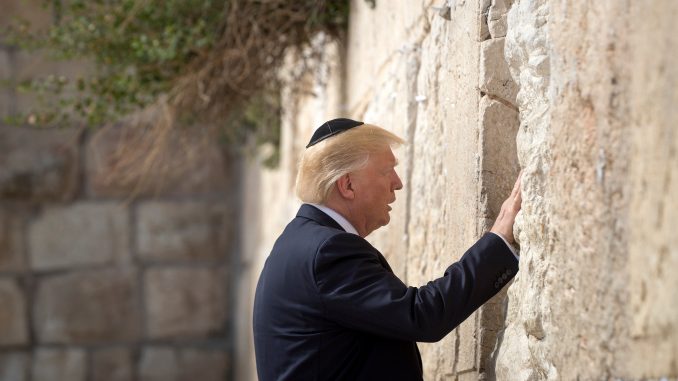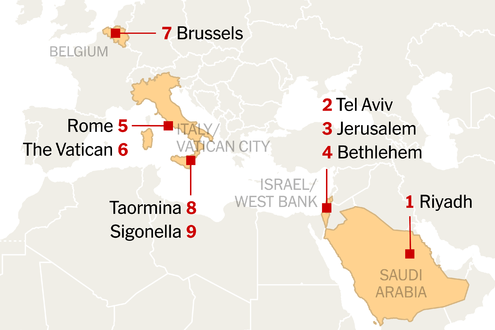
Guide re-produced here first written in 2006. Pathetically, still completely relevant with almost no editing, more than ten years after. Top: Trump, perhaps contemplating, at Western Wall in Jerusalem. Below: Trump at a welcoming ceremony in Tel Aviv on Monday.
The Emotional Tangle
1) In the Middle East, all concerned are totally convinced that God is on their side – at the same time, all concerned also have blood on their hands – all of them, and a lot of blood, too.
2) In laying out their narrative of how this miserable situation has emerged, most of what any one group says about its adversaries is pretty much correct – the problem is that they all leave out of their account any mention of anything THEY might have done to contribute to the on-going mess.
3) Speaking globally, nearly everyone in the world has a very strong – and very emotional — opinion about what goes on in the region – especially, although not exclusively, in Israel / Palestine – but at the same time, no one – including the actors themselves – have the slightest idea of what’s motivating the other actors in the situation … except, of course, having instinctive knowledge about how to push the “Other’s” emotional buttons.
President Trump’s Schedule for His First Foreign Trip

The People
4) There are five politically relevant dominant ethnic groups: 1) Israelis / Jews; 2) Arabs / Palestinians; 3) Turks; 4) Iranians / Persians; 5) Kurds.
Each one of these ethnic groups has numerous internal divisions – class, culture, religious identity, etc. – so ethnicity is merely a starting point for making sense of the complex human geography of the region.
5) While the dominant religion is, of course, Islam, there are also historical and culturally relevant Jewish and Christian communities as well … not to mention the increasingly violent divisions within Islam, especially between the Sunnis – who believe in a “consensus” notion of Islamic religious legitimacy – and the Shia – who see genetic descent from the Prophet (PBUH) as the key factor – a dispute which has existed since the late 600s.
6) Putting these two together, it’s important to realize that a) not all Arabs are Muslims – there are now large Christian, and before the establishment of Israel, were significant Jewish, communities in the Arab world ; b) not all Muslims are Arabs — Iranians and Kurds are Muslims, and antagonistic to the perceived dominance of Arab identity in the region; and c) not all non-Arab Muslims get along – both the Turks and Iranians, for example, are profoundly hostile towards the Kurds, as are the Arab states of Iraq and Syria, where Kurdish communities also live.
President Trump, center, with Prime Minister Benjamin Netanyahu, right, and President Reuven Rivlin of Israel.
The History
7) There were no nation-states in the Middle East until the break-up of the Ottoman Empire at the end of World War I — so no historical Palestine or Iraq or Jordan or Syria or Kuwait or Dubai / United Arab Emirates , and certainly not Israel. All these political entities were formed after 1919.
8) The process by which the Middle Eastern nation-state system came into being was overseen by the Mandate / colonial powers Britain and France, who made two choices with profound implications for the 20th and 21st century Middle East:
a) While they recognized two out of the three nascent nationalisms in the region – Arab and Jewish – they notably failed to take account of the third – Kurdish –
dividing what would otherwise have been a compact Kurdistan among four newly emerging nation-states,
who were, of course, determined to retain political control over the Kurdish-inhabited territory: Turkey, Iran, Iraq and Syria.
b) Within the Arab world, they tended to install Sunni groups as their local agents – who would become the “national” elites in the post-colonial era – as opposed to Shiites,
even in places like Iraq, Kuwait, Bahrain and other Arab regions of the Gulf that had majority Shiite populations within the lines the Europeans drew –
the exception, of course, being Lebanon, where minority Christians were favored.
Trump at a bilateral meeting with Rivlin in Jerusalem.
Israel / Palestine / Arab World
9) Despite the common belief in the West, there is no “centuries long conflict” dating from Biblical times between Jews and the Arab / Muslim world, where Jews, especially during the Ottoman time, generally had a decent, albeit second-class, status.
The conflict today is a direct result of the late 19th and early 20th century Zionist colonization of “Palestine” – which did not previously exist as any sort of separate political / cultural entity apart from the ummah arabbiyah, but was literally constituted as a result of the Zionist colonization.
10) Victory in that confrontation is not – despite Palestinian rhetoric – a result of Zionist / Israeli military superiority – although that aspect has become more pronounced in the post-1967 period – but arises from the superior political unity / social cohesion / economic dynamism / and technological advancement the Zionists / Israelis were able to bring to bear in the nation-building process.
11) Despite the primacy of the Palestinian dispossession in Arab / Muslim political rhetoric, practically speaking, the Palestinians have generally been treated with indifference and contempt by their Arab / Muslim “brothers,” with Jordan being the only Arab country to give them full rights and citizenship – otherwise, they have been either “guest workers” or penned up in miserable refugee camps.
Trump and his wife, Melania, visiting the Church of the Holy Sepulcher in Jerusalem on Monday.
Political Islam – Right Wing “Religion”
12) The dominant initial response to European colonialism and Zionist settlement was Arab nationalism – exemplified at its height by the “victory” of charismatic Egyptian leader Gamal Abdel Nasser in the 1956 Suez war – it was ended by the willingness in the late 1970s by the Arab regimes near Israel to basically accept its legitimate existence.
Today, the most dynamic political force in the Arab / Muslim world today is political Islam – whose core aim, like the Christian right in the US, is to institute a right-wing political agenda over society as a whole by smashing the wall between church / mosque and state.
As might be expected, the Sunni / Shiite split is replicated in the world of political Islam as well.
First to come to victory were the Iranian Shiites, during the revolution of 1979, a shock not just to the US and the West, but also the previously unchallenged Sunni Arab elites in the region, especially those ruling significant numbers of Shiites.
At just about the same time, the incredibly misguided Soviet invasion of Afghanistan in 1979 – like the US debacle in Iraq today – gave a huge boost to Sunni political Islam, whose most dramatic expression to date has been the attacks of September 11, 2001.
Trump at the Western Wall.
Sunni Arab Fear Of “Persian” Shiite Crescent
13) The most powerful expression of the struggle between Sunni and Shiite political Islam today is the fear all over the Sunni world – among religious and secular, elite and the street – of a Middle East transformed by the establishment of the so-called Shiite Crescent:
a geographically unified band anchored in Persian Iran – stretching into neighboring Iraq, the first political Islamic Shiite-ruled Arab state, whose clueless founder is George W Bush –
across a Sunni Syria ruled by the Arab nationalist Assads, a family of Alawites, a tiny Shiite sect, which goes a long way to explain the Syrian / Iran connection –
and then into a democratic / one person – one vote Lebanon dominated by the militant and dynamic Shiite political / military movement Hezbollah.
Source: Trump Comes to Israel Citing a Palestinian Deal as Crucial – The New York Times